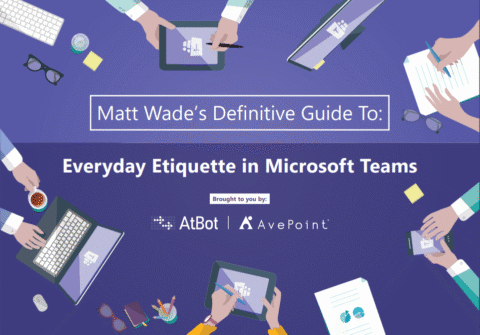The Definitive Microsoft Teams Etiquette Guide is Here! Read Now!

Want to take this guide with you wherever you go? Download the full PDF version here.
Microsoft Teams is a relatively new chat-based workspace app that’s meant to make collaborating and communicating within and outside of your organization as seamless as possible. That said, knowing how to navigate Microsoft Teams without unintentionally disturbing coworkers or creating a bloated, unstructured environment can be confusing for those new to the platform.
Matt Wade’s Definitive Guide to Everyday Etiquette in Microsoft Teams is here to help. We’ve teamed up with Matt to cover as many best practices as possible to ensure you and your colleagues have an optimal Teams experience.
This thorough Microsoft Teams handbook will cover:
- Conversations
- Channels
- Files
- Private Chat
- Bots
- Meetings and Calls
To give you an idea of what to expect in the full version, here are some of the most critical bullet points taken from the first few chapters of the ebook.

Conversations
- @mention individuals to get their attention and a response.
@mention-ing is equivalent to placing someone in the To or CC field of an email. Use @ accordingly; don’t overuse it.
- Urgency in conversations is comparable to the urgency of an email.
Don’t expect an immediate response even if you @mention someone in a conversation. Expect the response time to be similar to if you had sent an email. Use private chat for urgent messages.
- Don’t invite external guests unless everyone knows they’re there.
Guests have access to almost everything in that Team. Be sure everyone’s okay with that and acts accordingly once it’s opened up. You may need IT approval to share externally.

Private Chat
- Keep conversations ad hoc.
If the discussion starts getting into business decisions, bring it back to a channel. Work shouldn’t be completed in private chat.
- Newly added chat participants will see prior discussions in that chat.
If you add someone to a chat that’s been going on for a while, that new person will see all past conversations unless you select the option not to share the previous chat history. Before adding anyone, make sure it’s okay that they see what was discussed previously.

- Membership matters.
If you already have a chat going with three people and you create a new chat with those same three people, there will be two different chats with the same individuals in the two conversations. This can get confusing, so try to avoid it unless necessary.

Meetings and Calls
- Use video when circumstances and internet connection support it.
Video facilitates a much more effective meeting than audio.
- Stay on mute when you’re not talking.
Nobody wants to hear you cough or listen to your dog whimper about needing to go out.
- When sharing web pages, zoom in.
This helps your attendees see what you’re showing, which is usually smaller on their end.
Hungry for more on insight on proper Microsoft Teams etiquette? View the complete guide here!
As the former Content Marketing Specialist for AvePoint, Brent led the strategy and direction of all AvePoint's blog properties.



